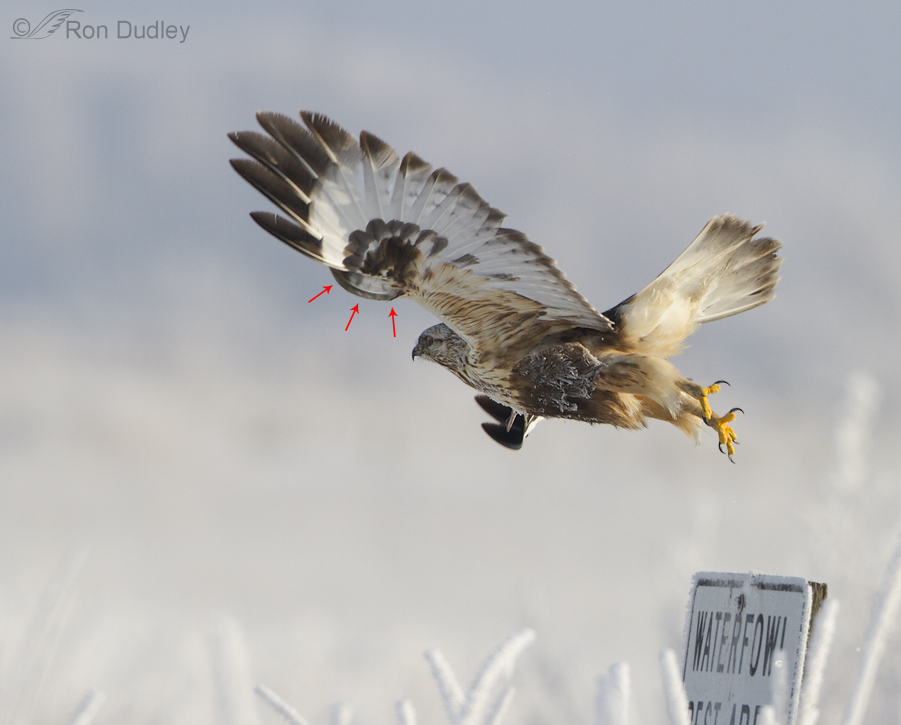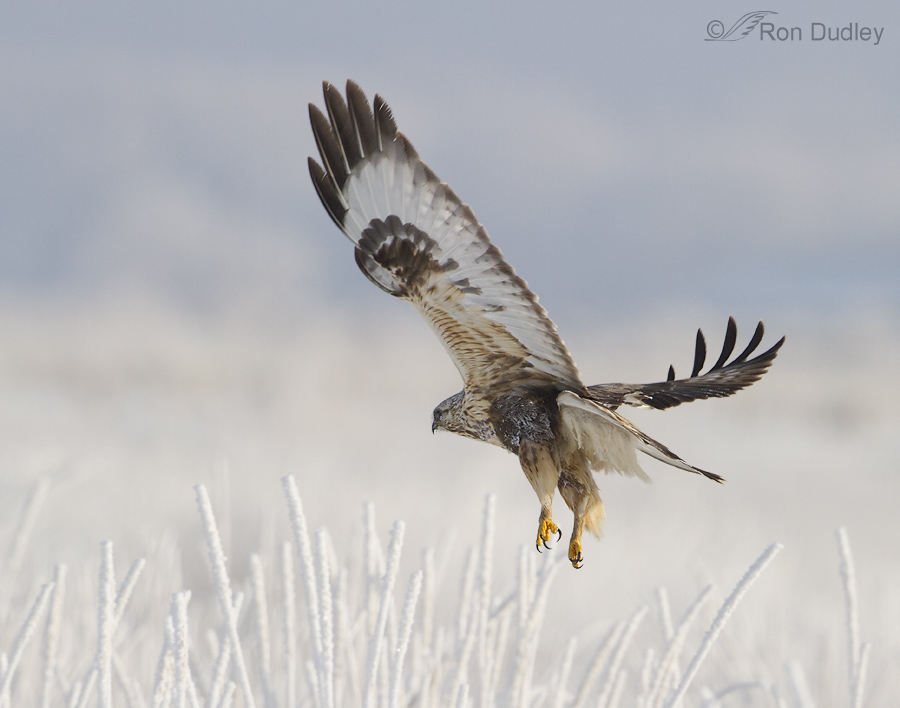Yesterday morning a Rough-legged Hawk gave me a perspective on the alula that I had never seen (or at least noticed) previously. I was on the verge of deleting these images when at the last second something about the left wing caught my eye.

That wing seemed misshapen at the “wrist”. At first I thought it must be part of the right wing behind it but quickly realized that it was the fully extended alula of the left wing (marked by red arrows here). I don’t recall having ever seen the alula extended this well from beneath and behind a bird in flight.
I’ve posted about the alula previously but here’s a summary if you missed it:
- The alula or “bastard wing” (plural – alulae) is the freely moving “thumb” or first digit of a bird’s wing. It bears 3, 4 or 5 small flight feathers, depending on species. The alula is like a small “winglet” attached to the wing. Normally the alula is held flush against the wing where it is seldom noticed but at slow flight speeds or when landing or taking off it can extend forward. This creates a small slot on the leading edge of the wing which functions similarly to the slats on the wing of an aircraft (which are also extended at slow speeds) and results in increased lift which prevents a stall at slow flight speeds.

Two frames in the burst later the alula has extended again (I believe it retracts on the up-beat but someone please correct me if I’m wrong).
One of the field marks of the Rough-legged Hawk is the conspicuous, almost square, dark carpal patch at the bend of the wing. I was struck by how well the dark colors and even patterns of that patch are continued into the extended alula. To this day researchers apparently aren’t sure if birds have muscular control over the alulae or their positions are determined by air pressure on the wing but evidence seems to be leaning to the latter.
Perhaps all this is of interest only to those of us who are “bird geeks” but when I notice something like this I can’t resist sharing…
Ron


Now that is something new to me, never heard of this before. Well captured, thanks.
As always, I enjoy your photography and just as much your comments/info on your subjects. I’ve known of the Alulas but this is one of the best shots I’ve seen, or it could be b/c it’s a raptor, which just happens to be one of my personal favorites. Thank you for sharing your passion and knowledge with us that are also very passionate about our fine feathered friends.
I am fascinated by this info Ron. I see the alula as functional in flight, whereas the “hallux” of their feet is probably more functional in terms of grasp, yet the ‘hallux’ is in their feet. This article on Wiki says: “Most birds have at least one opposable digit on the foot, in various configurations, but these are seldom called “thumbs”. They are more often known simply as a hallux.” What apparently happened in terms of evolution is that this ‘alula’ evolved within the wing to improve flight and some primitive ‘grasping’ function (as when a bird catches a prey on land, he then uses the alula to ’embrace’ or ‘wrap’, the prey so it doesn’t get away. But what is really working as a functional grasp with birds involves the ‘hallux’, whereas the alula seems to have evolved to benefit flight and primitive grasping functions such as embracing or wrapping prey or using this ’embrace’ for protecting their offspring. Can you please explain the function of the ‘mantle’ feathers?
Maria, I’m not sure what you mean by “mantle feathers”. Raptors often “mantle” over prey but to my knowlede that’s a behavior, not a structure.
Maria and Ron: the mantle is an area of the upper back, below the neck of a bird. I have some chores to do early this morning but will respond to the rest of Maria’s post later.
Bill
Oh okay, I though ‘mantle’ was actually part of the feather structure but now I see it’s not. Now I see it’s used in the ‘behaviour’ connotation of ‘mantling’, yet I’ve found very little info on the origin of the word and how it even relates to the behaviour. I know what it is, but I’ve also heard it being used as feathers. My bad.
Oh William thanks, I knew I heard about it somewhere.
The behavior “mantle” is from the behavior “to cloak”. This behavior involves the spreading of one or both wings and often the tail to hind (cloak) food.
Bill
Maria: In regards to raptors the Osprey and owls have one digit (the outer toe not the hallux, the back toe) that can be moved forward or back.
Anisodactyl is the term for a 3 forward and 1 toe back pattern while zygodactyl is the term for 2 and 2.
I’m not sure but perhaps your association with the alula and the hallux (or claw) is that some bird embryos have a alula claw (found on the wing while the bird/embryo is still in the egg) and is used to help the embryo turn while in the process of hatching.
Bill
Fascinating!!! Great information…
Maria, the hallux is always in the foot, no matter the species. In humans the hallux is the ‘big toe’.
I know that! The reason I brought the hallux up it’s because in birds the wings would be the ‘equivalent’ to the ‘upper extremity’ in humans, except in birds, the ‘thumb’ evolved into feathers and the alula; whereas in humans the thumb is a thumb. And for a bird’s functional grasp, the hallux would be considered capable of having one opposable digit on the foot which acts as a ‘thumb’; but nevertheless is a hallux; whereas the alula mainly evolved for flight and probably has many other uses such as what William said that in “some bird embryos have an alula claw (found on the wing while the bird/embryo is still in the egg) and is used to help the embryo turn while in the process of hatching.” See this ‘claw’ is already on the wing, whereas the “real” claw is the hallux. This is what’s so awesome about the evolution of birds, they developed wings AND claws; yet we remain with hands and feet! This is why I brought the hallux up.
Stunning shots and absolutely amazing commentary!
Charlotte
I am so grateful for the education I get from your posts (and your commenters). Megathanks.
Me too!
Thanks for sharing, I enjoyed learning about this.
Cool shots Ron, I like the frost on the bird.
Very interesting shots. The first photo is another of those optical illusion ones for me. It took me quite a while to figure out what the dark stuff was just under the bird’s body. I like seeing the different view of the alula.
Susan, If you think there’s an “illusion” here, just wait until tomorrow’s post…
very interesting information…Again, information like this make my own observation so much richer. If you out your finger over the feet in the first image, it looks like he’s wearing little black booties…That right wing must really be arced.
Glad to hear that posts like this enrich your own observations, Patty. Thank you.
“Two frames in the burst later the alula has extended again (I believe it retracts on the up-beat but someone please correct me if I’m wrong).”
You are correct Ron.
“To this day researchers apparently aren’t sure if birds have muscular control over the alulae or their positions are determined by air pressure on the wing but evidence seems to be leaning to the latter.”
There is some research which suggests that it is air pressure which activates the alulae.
Bill
Bill, thanks for the confirmation on the alula retracting on the up-beat.
Last night I think I found some of the research you mention that suggests it is air pressure that activates the alulae – a PDF entitled “On the Role of the Alula in the Steady Flight of Birds” by Alvarez, Meseguer, Meseguer and Perez.
I, too, really appreciate learning more about these marvelous flying beings – their intricacies and powers. I feel lucky to be able to learn from such beautiful photos!
Thanks for the compliment, Alison.
To me its their thumb. If you have ever stuck your hand out the window of a moving car and felt the wind push up on the palm of your hand, then maybe you did like me, and led with your thumb. Anatomicaly it is “thumb like” and can be seen as such. Of course this isn’t an orginal idea by any means, I’m just stating that I agree. For me, when Sakura flies back to the glove, she holds her wings in a pyramid shape, and picks up speed (a lot of speed….she likes to come in fast!). When she does this, her alulas are pointed right at me. I have often wondered if the sensitivity to lift, flight, or speed is located around the alula. As if she’s sticking her thumb into the wind to lead the rest of her wing…..
Tim
That’s really an interesting possibility, Tim. Makes you think…
I really envy the sights you see when Sakura is coming into the glove.
Who knew? I try to learn something new everyday and here I am this early in the morning. My day is done! Thanks Ron for very interesting information and beautiful pictures of beautiful birds.
Glad we started you early this morning, Rachel. Thanks.
I did not know either, but now I do! I will look for it. There is a stunning RL out where I run my dogs. His colors are just spectacular, more so than most. His head is so white he looks like a Bald Eagle from a distance. He’s become quite used to the dogs & doesn’t fly when we drive & run under him on his telephone pole perches. There are lots of rabbits on this road so I’m sure that’s why he hangs out there all the time. Can’t wait to look for his alulae!
Your bird sounds quite striking, Deb. Around here I always look for the dark morph. I seldom see them but it makes my day when I do.
Very interesting Ron. I did not know about the alulua. Beautiful photos as always. Your e-mails / blog posts are the best part of e-mail day now, I really look forward to them. Thank you.
What a nice thing to say, Ed. Thanks a lot.
Both Very Cool, Dynamic Captures Ron! And thank you for the interesting and eclectic information you always provide.
I’m glad you find this kind of stuff interesting, John. Probably not everyone does but I try to provide some variety in my posts.